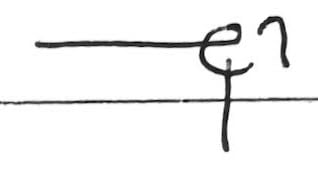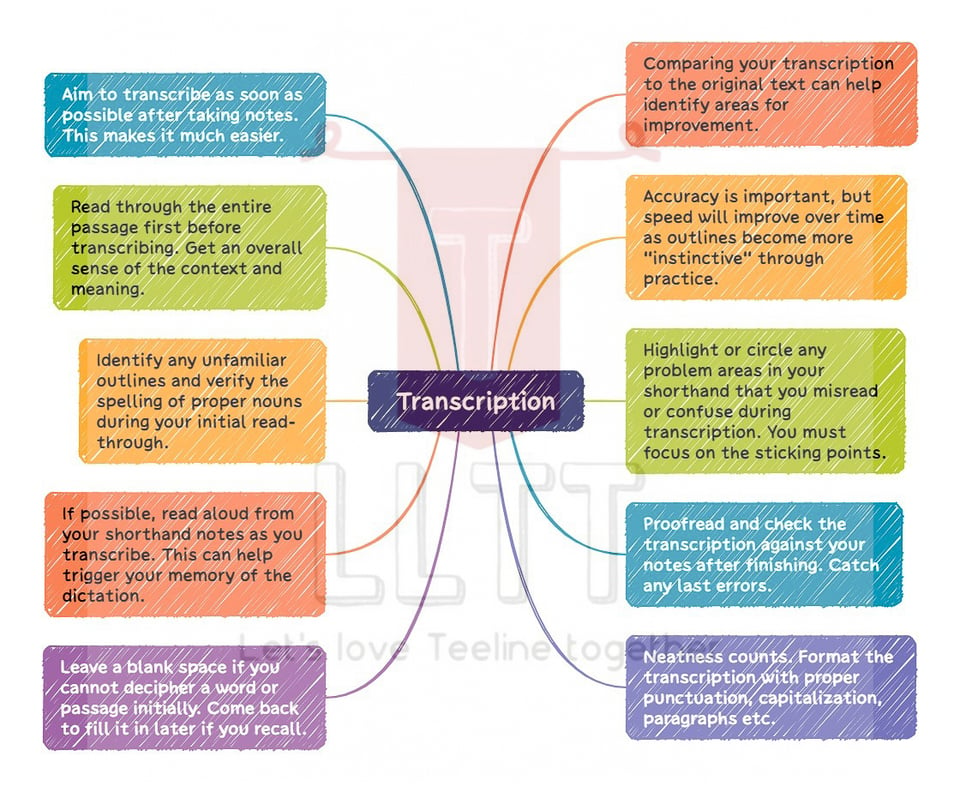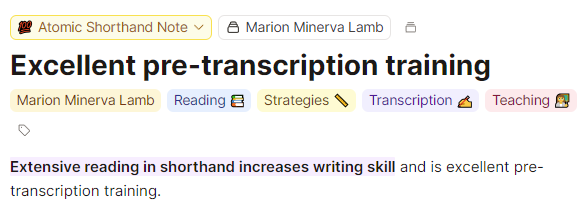LLTT Newsletter - January 2025

LLTT - January 2025
Welcome back!
In this month’s edition, we’ll provide some of our thoughts about Transcription and why it’s an important skill that everyone should master and not something that should be relegated to just those taking exams.

Towards the end, we’ve also included a link to a timely article from The Guardian which examines the broader context of handwriting's role in our digital age.
Thoughts on Teeline Transcription

The Critical Role of Regular Transcription Practice
The Exam-Only Mindset: A Common Mistake
One of the most dangerous habits in shorthand is treating transcription as an “exam-only” skill. Many students focus solely on taking notes, believing they can deal with transcription later when preparing for examinations. This approach often leads to a rude awakening during testing, where seemingly clear notes become puzzling hieroglyphics under pressure.
Why Regular Transcription Training Matters
You’ve heard it before, but it bears repeating. In the early stages of learning, everything taken down should either be read back or transcribed (preferably both). This isn't just busy work - it's a fundamental part of the learning process. Here's why:
1. Building Recognition Patterns
- Regular transcription (and reading) practice helps your brain create stronger connections between outlines and their meanings
- Moreover, you learn to recognise your own writing quirks and adjust accordingly.
- Pattern recognition becomes more automatic, which is essential for speed building studies later
2. Developing Confidence
- Consistent effort builds trust in your note-taking abilities
- Over time, you learn which outlines work best for you
- More confidence during exams comes from hundreds of successful transcriptions
3. Identifying Weaknesses
- Regular transcription reveals problem areas early
- With careful study, you can start to spot patterns in your mistakes
- Issues can be addressed before they become habits
4. Speed Development
- Transcription skill directly impacts your overall “speed” with shorthand
- You learn to write outlines that you can read easily
- Clear, readable notes allow for faster transcription
The Real-World Connection
Remember that in professional settings, notes that cannot be transcribed are worthless. Journalists and other professionals need to be able to read their notes accurately, often hours or days after taking them. The ability to transcribe quickly and accurately isn't just an exam skill - it's a core professional competency.
Making Transcription Part of Your Routine
- Transcribe every session's notes
- On some occasions, wait 24 hours (or more) and then try to transcribe
- Keep a log of transcription errors
- Read Teeline wherever possible
- Set personal transcription speed goals
“Without a destination in mind, any map becomes pointless.”
Remember!
Make transcription an integral part of your learning journey from day one. The time invested in transcription will pay dividends not just in examinations, but throughout your career. Your goal should be to make transcription as natural as taking notes. Only then will you have truly mastered Teeline shorthand.
Understanding Why Transcription Errors Happen
Transcription errors in Teeline often occur due to several key factors:
- Word-by-word transcription without context
- Rush to complete transcription within certain time limits
- Fatigue during long transcription sessions
- Panic when encountering unclear outlines
- Lack of proper preparation (training)
Common Transcription Mistakes and Their Solutions
1. Word-by-Word Reading
The Problem:
Reading each word in isolation can lead to misinterpretation, especially with similar outlines.
The Solution:
- Read ahead by a few words
- Keep the context of the passage in mind
- Look at surrounding words when uncertain about an outline
- When in doubt, try reading in phrases rather than individual words
2. Altering Shorthand Notes
The Problem:
Some writers attempt to modify their shorthand notes when they can't read them back, trying to make them match what they think was said.
The Solution:
- Never alter original shorthand notes
- Circle incorrect outlines and write corrections in the margin (or add them to your Focus Lists for later study)
- You must learn to “trust” your original notes
- Remember that shorthand notes might be needed as legal evidence
3. Misplaced Punctuation
The Problem:
Incorrect placement of punctuation can completely change the meaning:
The Solution:
- Listen carefully for voice drops or inflections indicating sentence endings
- Mark full stops clearly as you write.
- Don't rely on spaces or new lines to indicate sentence endings
4. Context Ignorance
The Problem:
Failing to use context clues when deciphering unclear outlines.
The Solution:
- Read the whole sentence before transcribing
- If stuck on a word, look at the words that come before and after. Use common sense. Stop and think
- Consider what would make sense in the context
- It’s important to keep the subject matter in mind while transcribing
5. Longhand Interference
The Problem:
Using longhand in shorthand notes can:
- Lead to examination penalties
- Slow down writing speed
- Create confusion during transcription
- Break the flow of shorthand writing
The Solution:
- Never write in longhand during note-taking
- Use proper Teeline outlines for all words
- If unsure of an outline, use basic Teeline principles
- In your revision work, keep a list of challenging words and phrases (and their associated outlines and/or groupings)
Accurate Transcription
Preparation
1. Read through notes completely before starting transcription
2. You must plan your time carefully if working under examination conditions
During Transcription
1. Keep your finger just below the outline being transcribed
2. Look ahead while reading
3. Maintain awareness of the passage's overall meaning
Double-Checking
1. Read through the completed transcription
2. Check against shorthand notes if time allows
3. Watch out for small words that might be missing and/or hyphenated words if your word count is “off.”
Special Considerations for Examinations
Time Management
- Read through notes before starting the transcription
- Allocate time for checking
- Don't spend too long on problematic outlines or groupings
- Leave space for uncertain words and return to them later
Remember:
- Transcription is a skill that improves with time and dedication
- Context is your best friend when reading back notes
- Trust your original shorthand
- Stay calm when encountering difficult outlines
- Maintain a systematic approach to transcription
Final Tips
- Don’t ignore transcription. It is an important and necessary skill.
- Read back or transcribe everything in the early stages of your learning
- Mark and study your errors to prevent repetition. Shorthand is one of those skills where you must focus on your weaknesses. You cannot rely solely on your strengths.
- Build confidence in your ability to read your own notes
- Remember that consistency in shorthand leads to easier transcription
ICYMI the first time:

Taking a shorthand exam
Oct 25, 2023 - Jo Goodall - Even if you are not at the 100 wpm stage yet, there are some good tips in this one.
Worthy of Note
Are we losing the ability to write by hand?

Signature moves: are we losing the ability to write by hand? | Technology | The Guardian
We are far more likely to use our hands to type or swipe than pick up a pen. But in the process we are in danger of losing cognitive skills, sensory experience – and a connection to history
The article ultimately argues for maintaining handwriting alongside digital technologies, viewing its decline as part of a broader pattern of losing direct physical experiences in our increasingly screen-based world.
The Decline of Handwriting
- Many students can no longer write or read cursive
- Schools are removing handwriting requirements from curricula globally
- Even basic handwriting competency is declining, with 33% of students struggling
Cognitive and Learning Impact
- Research shows handwriting aids learning better than typing
- Students who take notes by hand perform better on conceptual questions
- Handwriting forces better information processing
Cultural and Historical Implications
- Loss of ability to read historical documents and family letters
- Diminished connection to personal history and individuality
Physical and Sensory Loss
- Reduction in fine motor skills and dexterity
- Loss of embodied experience and physical connection to writing
- Part of a broader trend of losing hands-on skills in the digital age
Technology's Role
- Not inevitable that new technology must eliminate old skills
- Possibility for coexistence between digital and traditional methods
- Need to balance efficiency with preserving valuable human experiences
Be sure to visit us at the LLTT Website, YouTube, Facebook, Instagram, Quizlet and Soundcloud.
If you’re looking for Teeline reading practice, Skill Building Through Reading 📗 - is available for purchase online.
Much work (and ❤️!) has gone into this 48 page, 6”x9" softcover book:
Five 5️⃣ carefully selected passages: Improve your sight 👁️ recognition of outlines and word groupings.
Dual Format: Each passage includes both printed Teeline and the longhand ✍️ transcription.
Proven Learning Approach: Reading printed 🖨️ shorthand is a method long-favoured by skilled practitioners.
Whether you're a student, journalist, or professional seeking to improve your note taking, this book will be a valuable addition to your Teeline learning resources.
To order, please visit the book’s landing page or respond to this email with any questions.
If you find this newsletter helpful, please help us spread the word and forward to a friend!
A Parting Thought


Add a comment: